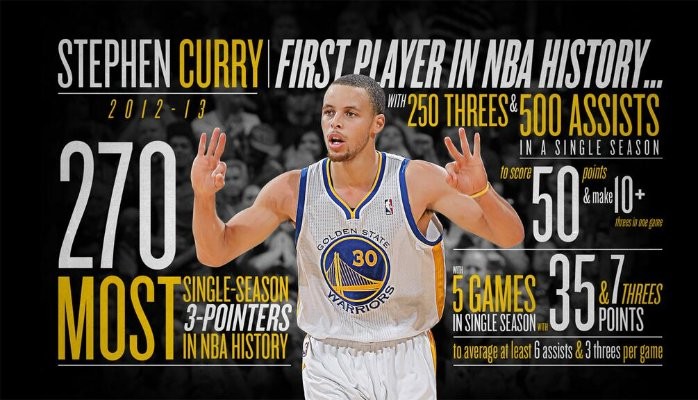
Why Business Metrics Are Like 3-Point Baskets
With one game left in the Golden State Warriors’ NBA regular season, their MVP Steph Curry has a chance to score an astonishing 400 three-point field goals this season. This remarkable accomplishment underscores why business metrics, and especially ratios, are such a powerful tool for understanding business trends and achievements. Here’s why: while the raw numbers alone can tell us who’s doing well, what’s getting better, and what’s getting worse, it’s the metrics that tell us about the magnitude of the accomplishment.
Curry’s 3-point shooting is just one facet of a Warriors’ season that is one of the most remarkable in the history of professional sports (more on that at the end of this piece). To all but the most die-hard pro basketball fans, though, 400 3-pointers is an accomplishment that’s hard to appreciate – it may be a record, but records get broken all the time. It’s when we break out the the metrics (which are usually just ratios) that we can really appreciate the accomplishment: 400 3-point field goals would eclipse the previous record – which happens to be 286, set by (you guessed it) Curry last year – by 40%!
Anyone who follows sports knows that most records are broken by much, much smaller margins than 40%. Six weeks ago, FiveThirtyEight, Nate Silver’s insightful and entertaining website on statistical analysis, ran an article entitled “Steph Curry Is On Pace To Hit 102 Home Runs.” Major League Baseball’s single-season home run record – one of the best-known records in all of sports, at least for Americans – has increased in three increments from 60 to 73 (or about 22%) over the last 87 years, so a 40% jump in a single year stands in profound contrast.
In other words, using ratios is a powerful tool for two reasons: (1) They put the raw numbers – which are usually hard to remember, let alone appreciate – into perspective, and (2) they provide additional context – by enabling us to compare an accomplishment against analogous accomplishments by other teams, or in other sports. We can use ratios to make similar comparisons in business, by comparing our results to companies that are much larger or smaller on an absolute basis, or even against enterprises in different industries.
So never overlook the humble ratio. Look for opportunities to create them. The information you present will be 100% better!
“Painting with Numbers” is my effort to get people to focus on making numbers understandable. I welcome your feedback and your favorite examples. Follow me on twitter at @RandallBolten. And see more about my writing and “Painting with Numbers” at www.painting-with-numbers.com.
If you like sports statistics and numerical oddities, here are a few other interesting tidbits about the Warriors’ remarkable 2015-16 season (with one game left to go in the regular season):
- They will either tie or beat the single-season record of 72 wins, set by the 1995-96 Chicago Bulls (with Michael Jordan).
- 54 consecutive home game wins from 1/31/15 thru 3/29/16 (i.e., 14 months!), an NBA record. And the 24 consecutive home wins in the 2015-16 season is an NBA record for the start of a season
- 28 consecutive wins from 4/9/15 thru 12/11/15, the second-longest streak in NBA history
- Before the Warriors beat the Spurs yesterday in San Antonio, the Spurs had won all 39 home games in the 2015-16 season, and were on the verge of becoming the only NBA team ever to win every home game in the regular season.
- The Warriors’ win against the Spurs was the first time they had won in San Antonio since 1997!!
- Steph Curry has now scored at least one 3-point field goal in 151 consecutive games, another NBA record. Compare that to, say, Joe DiMaggio’s record of having gotten a base hit in 56 consecutive games, a major league record that has stood since 1941.
- Curry has sunk several baskets from beyond mid-court in 2015-16. And some of them actually counted!!
Accounting Manager, Investors Title Insurance Company
8yRandy - always find your work interesting (enough to buy the book) but, not to take anything away from Curry's ridiculous season, I feel your comparison of his 151 game 3-pt streak to DiMaggio's hit streak to be off base. As Kobe Bryant's 50-shot performance in his finale showed so well, NBA scoring is one of opportunity that is largely controlled by the player and his team. While Curry's .454 3-pt shooting % is an impressive 28% better than the league avg of .353, DiMaggio was slightly more superior to his league with his batting average of .357 at 34% better than the league's .266. The real difference though is that Curry threw up better than 11 3-pt shots per game. A league average shooter with 11 opportunities would make nearly 4 3-pt baskets per game and if Curry's streak were ever in jeopardy, it is fully within his control to increase those opportunities. In contrast, DiMaggio was at the mercy of the game just waiting for his 4-6 turns at the plate each game to cement his place in history. Regardless, congratulations to Steph Curry and the Warriors on a truly historic season -- even as difficult as it was for us Bulls fans to watch the record fall.